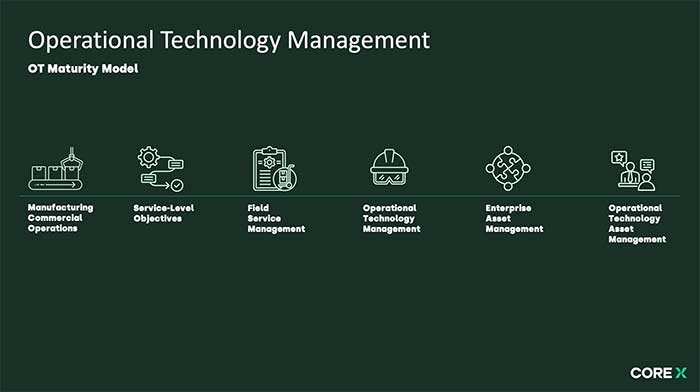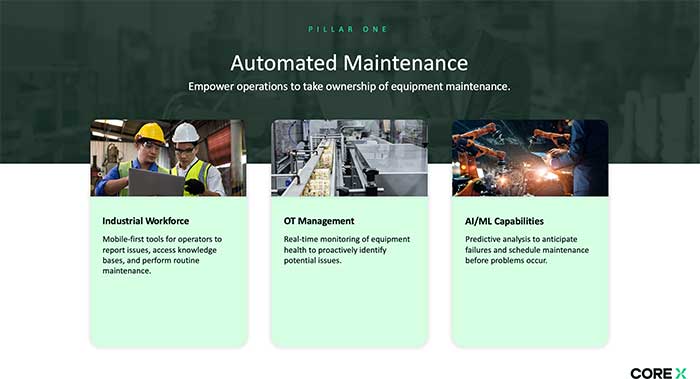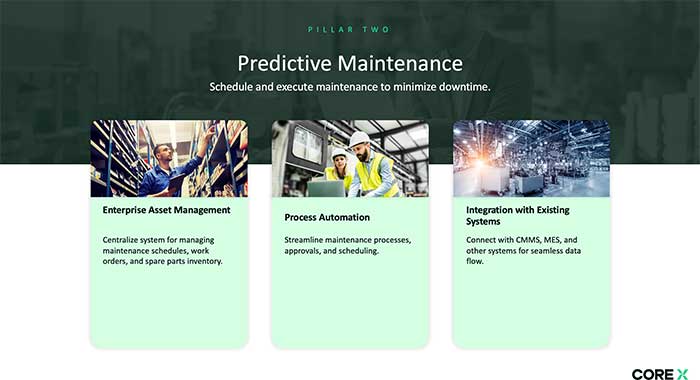Manufacturing’s $147B blind spot: disconnected operational technology systems prevent predictive analytics and create security risks.
By Ross Rexer, CoreX
While 98% of manufacturers have started their digital transformation journey, a critical gap is costing the industry billions: operational technology management.
ERP market spending has reached $147.7 billion as organizations seek to modernize their operations; however, disconnected OT systems prevent companies from consolidating and analyzing critical operational data, creating costly inefficiencies and cybersecurity vulnerabilities that threaten entire operations.
The stakes couldn’t be higher. Companies using industry-specific solutions generate 9.7% revenue growth, compared to just 6.6% for those relying on generic systems, according to recent research in the manufacturing industry. Yet many organizations still depend on manual processes and legacy knowledge to manage their plant floor operations, creating a widening gap between operational reality and digital potential.
Manufacturing operations represent a complex orchestration where plant management, maintenance, production, quality control, engineering, risk, security, and health and safety must work in seamless coordination to deliver optimal results. Yet this intricate process is often performed without proper operational visibility.
The fundamental challenge lies in disconnected systems that make it nearly impossible to consolidate and analyze OT data for predictive analytics. Without a trusted, unified system of record, organizations struggle to track OT devices, making monitoring and security ineffective. Legacy systems are riddled with security gaps, making it difficult to identify and prioritize critical devices for remediation.
Real-world implementations demonstrate the severity of this challenge. Manufacturing case studies show that firmware vulnerabilities in safety equipment can create enterprise-wide security risks, with manual remediation processes taking up to eight months to complete.
However, organizations with proper OT management systems can resolve similar critical safety issues across entire enterprises in as little as 30 days, demonstrating the operational and safety advantages of connected operational technology platforms.

As AI transforms manufacturing operations, the gap between outdated workflows and next-generation automation continues to grow. Industry 4.0 introduced connectivity, but Industry 5.0 brings AI-driven intelligence, demanding a fundamental shift in how manufacturers approach operational technology.
This evolution comes at a critical moment. Recent manufacturing research shows that 51% of manufacturers cite funding challenges as their biggest obstacle to implementing technology strategies — up from 35% in 2024. Meanwhile, 80% are exploring AI but struggling with implementation complexity, data security concerns, and the challenge of bridging IT and OT systems.
The pressure is mounting from multiple directions. Manufacturing is now “the industry most vulnerable to IoT attacks” due to interconnected environments that continue to expand. Yet the same connectivity that creates vulnerability also enables unprecedented operational intelligence when properly managed.
The transformation isn’t just about connectivity—it’s about intelligence. Modern OT management leverages agentic AI, event management, and existing data collection systems to move from reactive to proactive and even predictive operations. This approach automates work creation, assignment, and triage for faster issue resolution and optimized performance.

Manufacturing implementations demonstrate significant operational improvements when intelligent OT management is properly deployed. Organizations can achieve proactive maintenance capabilities and gain comprehensive visibility into all plant devices through advanced asset management functions. Mobile-enabled platforms eliminate manual processes, such as clipboards and paper-based logging, enabling real-time tracking through mobile devices.
The operational results are substantial. AI and predictive capabilities streamline maintenance operations, reducing defects through proactive corrective actions and cutting costs associated with defect resolution. Quality management systems can be integrated into centralized databases, correlating quality issues with their root causes and enabling continuous improvement through AI-flagged critical incidents.
As manufacturers embrace connectivity, cybersecurity becomes paramount.
Operational technology has historically lagged behind IT systems in vulnerability management, yet the security risks are equally serious. Any vulnerability exposed on internet-connected operational technology can be exploited by malicious actors, creating enterprise-wide security threats.
The European Union’s NIS2 Directive addresses this challenge by expanding cybersecurity coverage to include companies implementing OT, particularly in manufacturing. Smart manufacturers are recognizing that proper OT management is predominantly about business survival.
The business impact of inadequate OT security is severe. SmileDirectClub provides a cautionary example: in 2021, while still recovering from the effects of COVID-19, the company suffered a cyberattack that affected its manufacturing systems. The security breach contributed to their eventual Chapter 11 bankruptcy filing in 2023, demonstrating how operational technology vulnerabilities can threaten business continuity.
Unplanned downtime remains one of the costliest threats in manufacturing, hindering productivity, straining resources, and exposing vulnerabilities across operations. A recent case study demonstrated how a global automotive manufacturer, with more than 5,000 sensors, PLCs, and robots, utilized AI-driven OT management to reduce unplanned downtime by up to 30% and decrease defect rates by up to 40%.
By transforming alarms into automated incidents and enabling real-time diagnostics through digital twins and AI assistants, the company turned a reactive environment into a predictive, resilient system.
Modern OT management consolidates data from multiple sources, utilizing frameworks such as the Purdue Model, in a single configuration management database. This breaks down silos and enables predictive analytics by mapping OT assets, relationships, and production dependencies using standards like ISA-95.

The impact extends beyond operational efficiency. Engineering managers can now create capital proposals based on actual data rather than guesswork, quantifying and connecting the value of factory investments with day-to-day operations. AI-powered systems can predict equipment failures, optimize energy consumption, and coordinate responses across multiple plant functions.
Organizations that successfully implement comprehensive OT management consistently report significant operational improvements. Leading implementations demonstrate measurable gains across multiple operational dimensions:
The key is treating OT management not as a technology project but as critical infrastructure that enables intelligent manufacturing operations. Success requires a holistic approach that integrates security, operational efficiency, and strategic business objectives into a unified operational intelligence platform.
The opportunity is massive, but the implementation window is narrowing. The tools are available, the roadmaps are proven, and the business case is clear. The question isn’t whether to invest in operational technology management, but how quickly manufacturers can implement systems that turn their operational data into a competitive advantage.
As manufacturing leaders face mounting pressure from labor shortages, rising costs, and supply chain disruptions, operational technology management emerges as a strategic differentiator. Companies that invest in unified OT platforms position themselves to leverage AI, enhance their security posture, and achieve the operational agility necessary for future competitiveness.
The transition from Industry 4.0 to 5.0 isn’t just about adopting new technologies—it’s about creating intelligent, responsive manufacturing ecosystems that can adapt to changing conditions in real-time. Organizations that delay this transformation risk falling behind competitors who are already extracting value from connected, intelligent operations.
For manufacturing leaders, the path forward is clear: embrace comprehensive OT management as the foundation for intelligent operations, invest in platforms that bridge IT and OT systems, and build the operational intelligence capabilities that will define the next era of manufacturing excellence.

About the Author:
Ross Rexer is co-founder and head of service delivery at CoreX. He is a Management Consulting professional with 20+-year portfolio of success delivering technology transformation to global clients across a wide array of business sectors.
In this episode, I sat down with Beejan Giga, Director | Partner and Caleb Emerson, Senior Results Manager at Carpedia International. We discussed the insights behind their recent Industry Today article, “Thinking Three Moves Ahead” and together we explored how manufacturers can plan more strategically, align with their suppliers, and build the operational discipline needed to support intentional, sustainable growth. It was a conversation packed with practical perspectives on navigating a fast-changing industry landscape.